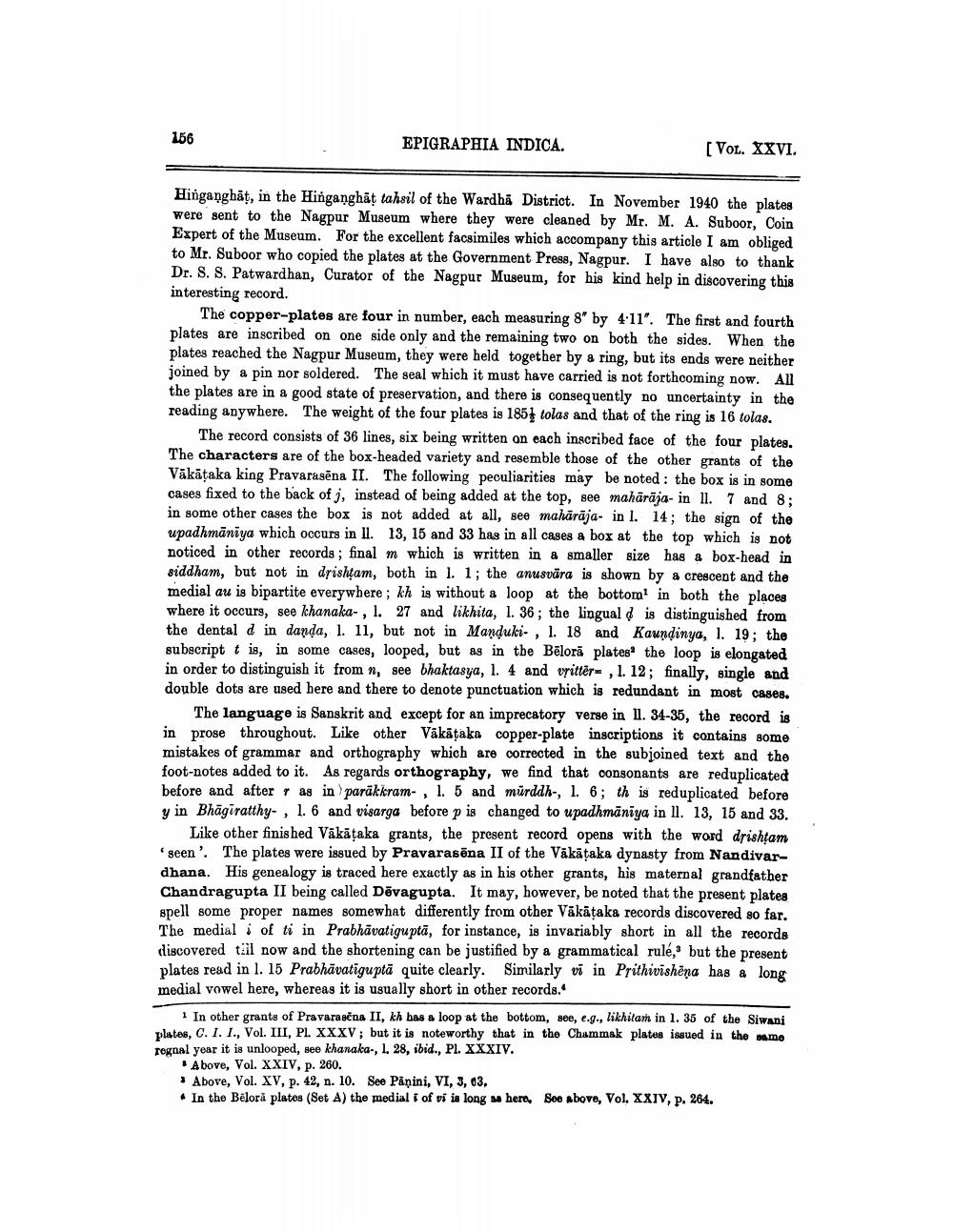________________
156
EPIGRAPHIA INDICA.
[Vol. XXVI.
Hingangbăţ, in the Hinganghāt tahsil of the Wardhi District. In November 1940 the plates were sent to the Nagpur Museum where they were cleaned by Mr. M. A. Suboor, Coin Expert of the Museum. For the excellent facsimiles which accompany this article I am obliged to Mr. Suboor who copied the plates at the Government Press, Nagpur. I have also to thank Dr. S. S. Patwardhan, Curator of the Nagpur Museum, for his kind help in discovering this interesting record.
The copper-plates are four in number, each measuring 8" by 4:11". The first and fourth plates are inscribed on one side only and the remaining two on both the sides. When the plates reached the Nagpur Museum, they were held together by a ring, but its ends were neither joined by a pin nor soldered. The seal which it must have carried is not forthcoming now. All the plates are in a good state of preservation, and there is consequently no uncertainty in the reading anywhere. The weight of the four plates is 1851 tolas and that of the ring is 16 tolas.
The record consists of 36 lines, six being written on each inscribed face of the four plates. The characters are of the box-headed variety and resemble those of the other grants of the Vākātaka king Pravarasēna II. The following peculiarities may be noted: the box is in some cases fixed to the back of j, instead of being added at the top, see mahäräja- in l. 7 and 8; in some other cases the box is not added at all, see mahārāja- in l. 14; the sign of the upadhmāniya which occurs in 1l. 13, 15 and 33 has in all cases a box at the top which is not noticed in other records ; final m which is written in a smaller size has a box-head in siddham, but not in drishtam, both in l. 1; the anusvāra is shown by a crescent and the medial au is bipartite everywhere; kh is without a loop at the bottom in both the places where it occurs, see khanaka-, l. 27 and likhita, 1. 36; the lingual d is distinguished from the dental d in danda, 1. 11, but not in Manduki- , l. 18 and Kaundinya, 1. 19; the subscript t is, in some cases, looped, but as in the Bēloră plates the loop is elongated in order to distinguish it from n, see bhaktasya, l. 4 and vritter- , 1. 12; finally, single and double dots are used here and there to denote punctuation which is redundant in most cases.
The language is Sanskrit and except for an imprecatory verse in 11. 34-35, the record is in prose throughout. Like other Vākāțaka copper-plate inscriptions it contains some mistakes of grammar and orthography which are corrected in the subjoined text and the foot-notes added to it. As regards orthography, we find that consonants are reduplicated before and after r as in paräkkram- , l. 5 and murddh-, 1. 6; th is reduplicated before y in Bhāgiratthy- , 1.6 and visarga before p is changed to upadhmāniya in 11. 13, 15 and 33.
Like other finished Vākātaka grants, the present record opens with the word drishtam geen'. The plates were issued by Pravarasēna II of the Vākātaka dynasty from Nandivardhana. His genealogy is traced here exactly as in his other grants, his maternal grandfather Chandragupta II being called Dāvagupta. It may, however, be noted that the present plates spell some proper names somewhat differently from other Väkäţaka records discovered so far. The medial i of ti in Prabhāvatiguptă, for instance, is invariably short in all the records discovered tail now and the shortening can be justified by a grammatical rule, but the present plates read in l. 15 Prabhāvatigupta quite clearly. Similarly vi in Prithivishēna has a long medial vowel here, whereas it is usually short in other records.
1 In other grants of Pravaraačna II, kh bas a loop at the bottom, see, e.g., likhitan in 1. 36 of the Siwani plates, C. 1. I., Vol. III, PL. XXXV; but it is noteworthy that in the Chammak platus issued in the same regnal year it is unlooped, see khanaka., 1. 28, ibid., Pl. XXXIV.
. Above, Vol. XXIV, p. 260. • Above, Vol. XV, p. 42, n. 10. See Påņini, VI, 3, 03. • In the Belora plates (Set A) the medial of vi is long as here, See above, Vol. XXIV, p. 264.




